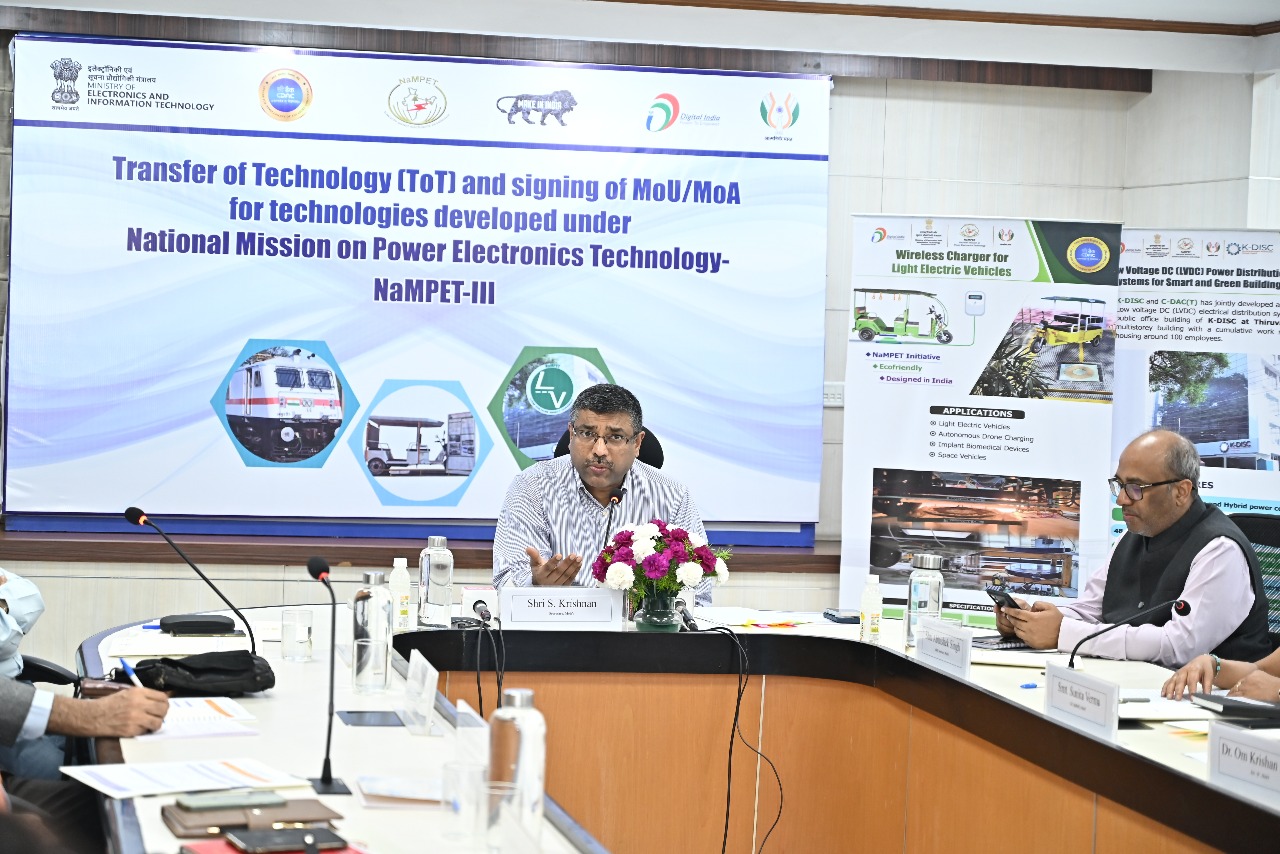India’s Technological Milestones: NaMPET Technologies Set for Commercialization
Another significant achievement was the signing of a Memorandum of Agreement (MoA) for the development of an indigenous propulsion system for electric locomotives.

- Country:
- India
In a landmark event at Electronics Niketan, New Delhi, Shri S. Krishnan, Secretary of the Ministry of Electronics and Information Technology (MeitY), unveiled the commercialization of cutting-edge technologies developed under the National Mission on Power Electronics Technology (NaMPET). These technologies, which span key sectors like electric vehicles (EVs), rail electrification, and sustainable energy solutions, were showcased as examples of MeitY’s vision to advance indigenous capabilities and foster industry-academia-government collaborations.
During the event, the Secretary addressed the need for self-reliance in the power electronics sector and emphasized the importance of technological innovations that can drive India’s journey towards energy sustainability and electrification. Key industry stakeholders, including representatives from the Ministry of Power, Ministry of New and Renewable Energy (MNRE), NITI Aayog, Ministry of Railway, and industry leaders from the EV, rail, and renewable energy sectors, attended the event.
Wireless Charger for Electric Vehicles: A Step Towards EV Revolution
One of the major highlights of the event was the transfer of technology (ToT) for the indigenous 1.5 kW Wireless Charger for Electric Vehicles, a technology jointly developed by C-DAC (T) and the Visvesvaraya National Institute of Technology (VNIT), Nagpur. This wireless charger, which operates on a 230V, 50Hz AC single-phase supply, offers a rapid charging solution for EVs. It charges a 4.8 kWh onboard battery pack at 48V with a current of 30A, achieving a remarkable charging time of approximately 3 hours. The charger incorporates advanced Silicon Carbide-based MOSFETs operating at 88kHz and achieves an impressive efficiency of 89.4% within a coil separation range of 7.5–12.5 cm. To ensure safety, the charger includes short-circuit and open-circuit protection, setting new standards in wireless EV charging technology. This technology is now being commercialized by M/s Global Business Solution Pvt. Ltd.
Indigenous Propulsion System for Electric Locomotives: Revolutionizing Indian Railways
Another significant achievement was the signing of a Memorandum of Agreement (MoA) for the development of an indigenous propulsion system for electric locomotives. This initiative involves collaboration between C-DAC, Chittaranjan Locomotive Works (CLW), and several industry partners, marking a pivotal step in India's rail electrification efforts. The MoA aims to develop a cutting-edge propulsion system for 3-phase electric locomotives, aligning with the Indian Railways' target of achieving full electrification by 2030.
The proposed propulsion system features two high-power 2.5 MVA Traction Converters, three 130 kVA Auxiliary Converters, and an advanced Train Control and Management System (TCMS), offering enhanced performance, reliability, and operational flexibility. With the involvement of key industry players such as Daulat Ram Engineering Services Pvt Ltd (Bhopal), JMV LPS Ltd (Noida), and Electro-waves Electronics Pvt Ltd (HP), this collaboration is expected to result in rigorous testing, prototype deployment, and field validation by Indian Railways, ensuring a smooth and successful commercialization process. This MoA is a testament to the synergy between government, academia, and industry in driving India’s rail electrification ambitions.
LVDC Systems for Green Energy Integration: A Sustainable Solution for Kerala
The event also saw the signing of a Memorandum of Understanding (MoU) between C-DAC and the Kerala Development and Innovation Strategic Council (K-DISC) to deploy the 48V Low Voltage Direct Current (LVDC) system. This innovative system, developed under the NaMPET program, represents a game-changing advancement in energy conservation and green energy integration. The LVDC system provides a cost-effective and energy-efficient alternative to conventional power distribution, enabling a significant reduction in energy consumption.
The K-DISC has implemented this LVDC system at its headquarters, making it the first administrative building in Kerala to be powered by 48V DC. The technology promises to lead to energy savings of 20–30%, contributing significantly to Kerala’s Carbon Neutrality Roadmap for 2050 and India’s ambitious Net Zero target by 2070. The MoU reflects a growing trend of adopting green energy solutions across various sectors, paving the way for more sustainable energy consumption patterns in India.
Fostering Industry-Academia-Government Synergy for Technological Advancement
The event also underscored the importance of fostering industry-academia-government partnerships to accelerate the deployment and commercialization of these technologies. The MoA and MoU signings signify a crucial step towards the commercialization of technologies that can drive economic growth, sustainability, and India’s technological self-reliance. The collaboration between organizations like C-DAC, industry players, and research institutions is a testament to the growing strength of India’s innovation ecosystem, ensuring that these technologies are tested, validated, and deployed to meet the growing demands of the Indian market and beyond.
These technological advancements are poised to transform sectors such as electric mobility, rail transportation, and energy distribution, contributing to the government's vision of a greener, smarter, and more sustainable future for India. As the NaMPET technologies make their way to the commercial sector, they will not only enhance the country’s industrial capabilities but also play a pivotal role in India’s journey towards achieving its sustainability and electrification goals.










